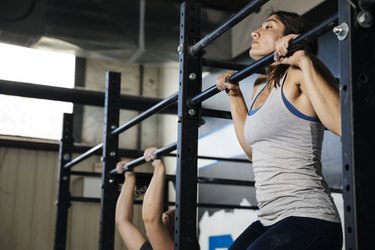
Muscle-ups are like skydiving or bouldering: Post videos of yourself doing them on social media and you'll get comment after comment on just how cool you are. But muscle-ups aren't just a party trick that earn you kudos — they're a full-body exercise that improves balance, upper-body strength and endurance, hip drive and so much more.
A (very) high-skill movement, muscle-ups are (somewhat) commonplace in CrossFit and calisthenics gyms. But even if you belong to one of those specialty sweat spots, getting the hang of muscle-ups is quite the undertaking.
Video of the Day
"Learning how to do a muscle-up requires a prerequisite level of strength, body awareness and a significant degree of gymnastics skills," says CrossFit coach Kyle Baughman, CF-L2, head coach and owner of Golden Goose CrossFit.
Learn exactly what it takes to do both the bar muscle-up and ring muscle-up below. Plus, we'll share the move's benefits, form tips, safety tips and how you can work up to nailing this exercise.
- What is a muscle-up? A muscle-up is an exercise that involves starting from a dead hang on a pull-up bar or gymnastics rings, Baughman says. Then, in one fluid motion, moving yourself into a fully supported position on the top of the pull-up bar or rings. In CrossFit, the term muscle-up implies a ring muscle-up, while the exercise always specifies "bar" when the movement in question is a bar-muscle-up. The exercise can be strict or with momentum, but generally momentum is allowed unless otherwise mentioned.
- What muscles are worked in a muscle-up? As you might guess from an exercise with the word "muscle" in its name, the muscle-up works nearly every single muscle in your body. The initial swing portion of the exercise (called a kip) activates your shoulders, lats and grip muscles, says physical therapist Grayson Wickham, DPT, CSCS, founder of digital movement platform Movement Vault. Then, when you drive your hips to propel your body over the top of the rings or bar, your core, glutes and hips are called upon. Finally, your triceps and pecs are engaged when you press out of the catch position and straighten your arms.
- What is the muscle-up good for? The muscle-up pays special attention to your entire upper body, which carries over to your daily life as well as in the gym. The hip drive you do during the muscle-up will make other exercises that require momentum easier, like the barbell snatch, barbell clean, chest-to-bar pull-up and toes-to-bar. The increased grip strength you get from muscle-ups can make activities like carrying groceries inside easier, and it can also help you lift more weight during exercises like the deadlift and farmer's carry.
- How do you train to do a muscle-up? Simply, with the long-game in mind. Both the bar and ring muscle-up require a high level of baseline full-body strength, coordination, body awareness and mobility. Once you've developed these prerequisites, you can start to do muscle-up drills that help you learn the skill of the muscle-up, such as the banded muscle-up, jumping muscle-up and kneeling ring muscle-up (more on these below).
- Who can do a muscle up? In theory, anyone with a baseline level of strength and upper-body mobility has the capacity to do a muscle-up if they commit to learning the skill. As for who chooses to? Well, that's hard to say. But it's estimated that less than 1 percent of the overall human population can do one with proper form, according to the Inspire Us Foundation.
- How many pull-ups should you be able to do before attempting a muscle up? You should be able to do 10 strict, unbroken pull-ups and 10 strict, unbroken triceps dips before attempting a muscle-up, according to CrossFit coach Conor Murphy CF-L3, managing partner at Big Night Fitness. "With this baseline level of strength, you're only a few coaching cues away from [being able to do] the movement," he says. Meaning, if you attempt the exercise before you've achieved that baseline, then you're at an increased risk injuring yourself trying. For the sake of analogy, trying to do a muscle-up before you can crank out double-digit triceps dips and pull-ups would be like trying to swim across a lake before you can swim across a 25-yard pool. In other words, dangerous and downright impossible.
How to Do a Ring Muscle-Up With Proper Form
- Find a set of hanging gymnastics rings that are 3 inches or more above your fingertips when your arms are outstretched (this gives you the room you need to swing).
- Jump up to the rings and assume a false grip, which involves placing the bend of your wrist over the top of the rings, so that your hand drapes over the bottom and your knuckles wrap over the top.
- From a hanging position, practice a hollow-hold position, which involves keeping your feet together and activating your midline to create a slight C-shape with your body.
- Move from a hollow-hold position into an arched-back position by pressing your head through your arms, spreading your shoulders and arching your lower back so your toes point back behind your body and the rings.
- Repeat the back-and-forth motion of the hollow-hold and arched-back positions to achieve what is called a gymnastics kip.
- When you’re ready to attempt the ring muscle up, as you come out of the hollow-hold position, drive your hips toward the space between the rings while pressing down hard on the rings, thinking about bringing your bellybutton to them.
- When your body is nearly parallel with the ground, keep your elbows tucked in tight to your body while simultaneously pulling your chest toward the rings, tossing your head through rings and pulling your legs back behind you.
- At this point, you're in something called the catch position, which is when the rings are at your hips, your elbows are bent back behind you, your midline is engaged and your legs are hanging down.
- From there, press down on the rings and use your triceps to extend your arms straight.
How to Do a Bar Muscle-Up With Proper Form
- Find a pull-up bar that is 3 inches or more above your fingertips when your arms are outstretched (this gives you the room you need to swing). Now, stand under the bar.
- Jump up to the bar with an overhand grip (palms facing away from you), hands at (or just outside) of shoulders-width apart.
- From a hanging position, practice a hollow-hold position, which involves keeping your feet together and activating your midline to create a slight C-shape with your body.
- Move from a hollow-hold position into an arched-back position by pressing your head through your arms, spreading your shoulders and arching your lower back so your toes point back behind your body and the bar.
- Repeat the back-and-forth motion of the hollow-hold and arched-back positions to achieve what is called a gymnastics kip.
- When you’re ready to attempt the bar muscle-up, come out of the hollow -hold position, and rather than going into the arched-back position, thrust your hips toward the bar and pull down on it with straight arms.
- After your hips pop toward the bar and you achieve full extension — at this point your body will be parallel with the ground — explosively throw your head through your arms to flip yourself over the bar. Think about doing a really fast sit-up or breaking a glass window with your head.
- Now that you’ve caught yourself above the bar, the only thing left to do is straighten your arms until you are fully out of the triceps dip position.
Ring Muscle-Up vs. Bar Muscle-Up: Which Is Easier?
The ring muscle-up is typically regarded as the muscle-up variation that's harder to learn of the two. That’s because the rings move while you do, which means your shoulder stabilizing muscles have to work overtime to keep you safe and in position.
However, some people find it easier to move their bodies with a piece of equipment (the rings) rather than around a piece of equipment (the bar), so there are certainly some folks who argue ring muscle-up is easier than the bar muscle-up.
The Benefits of a Muscle-Up
All variations of the muscle-up require a solid base of strength, mobility and body awareness, Murphy says. Working toward that foundation offers up a slew of fitness benefits.
1. You'll Build Upper-Body Strength
"The ring muscle-up is upper-body-focused exercise," Wickham says. During the pull portion of the exercise (the first half), you're calling on your lats, back and biceps, he says. Meanwhile, during the push portion (the second half), you're demanding your chest, shoulders and triceps to work, he explains.
Generally speaking, stringing together muscle-ups — that's CrossFit speak for doing multiple reps in a row without dropping from the ring or bars — will improve the endurance of these muscles. Meanwhile, wearing a ruck, weight vest or otherwise weighting the exercise with a medicine ball, for example, will further improve your upper-body strength.
2. You'll Improve Core Strength
From the time your feet leave the ground to the time they return, your core is working. "Your midsection is working the entire time you're doing a muscle-up — in particular, the anterior portion of the core," Wickham says. This includes your rectus abdominis (superficial six-pack muscles), external and internal obliques (the muscles on the sides of your abdomen) and transversus abdominis muscles (the deepest abs muscle).
By working these muscles when you do muscle-ups, you're strengthening them, which, in turn can reduce your risk of lower-back pain and so much more.
"All of your midline muscles work together to protect your spine and lower back, keep your standing upright, help you balance and give your limbs access to more power," Wickham says.
Plus, having a strong core reduces your risk of falling and therefore falling-related injuries, as well as supports the health of your surrounding joints.
"If you have a weak core, the other surrounding joints are going to have to take over for the midline, which can result in overuse injury," Wickham says. Your upper back, hips and shoulders, in particular, will go into overdrive if your core isn't operating optimally.
3. You'll Have Strong, Powerful Hips
Due to the amount we sit during the day, most people have weak hip flexors, according to Wickham. Why? Simply because when you're sitting, you're not using those muscles, and your body generally adheres to a "if you don't use it, you lose it" philosophy.
If you properly prepare your hips for doing muscle-ups and use them correctly when doing muscle-ups — rather than compensating for subpar technique by using just your arms — you're supporting the health of these muscles, Wickham says.
"By moving your hips through flexion and extension, you are making sure your hips continue to have access to that range of motion and are strong in that range of motion," he says, which supports the overall health of this muscle group.
Being able to extend through your hips during the muscle-up will have carryover to other movements that require hip extension, such as the snatch, clean and GHD sit-up, Wickham adds.
4. You'll Have a Reduced Risk of Injury
The muscle-up demands body control and awareness of your body in space, Wickham says, which is called proprioception. "Anytime your general body proprioception and control go up, it will translate to a better movement in life, which can reduce your risk of injury," he says.
5. You'll Be Able to Do Daily Activities With Ease
As advanced as this movement seems, being able to do a muscle-up actually has carryover to real life. If you can do a muscle-up, you'll have an easier time getting out of a pool, for instance, according to Travis Ewart, a gymnastics specialist coach at Invictus Fitness.
Form and Technique Tips for the Muscle Up
1. Nail the Correct Grip
It might sound obvious, but your hands are your only point of contact between the bar or the rings. So, if your grip on either isn't optimal, you're not going to be able to move as safely or as confidently as you would if your grip on the equipment was sound.
As far as the ring muscle-up is concerned, that means nailing the false grip (mentioned above). You can practice your false grip on low rings. You can also stand on a box off to the side of your high rings, then move your legs off the box and just hang from the rings with straight arms once you've perfected the grip. (Pro tip: Use lifting chalk on the bend of your wrists to increase the comfort of this grip).
Meanwhile for the bar muscle-up, Ewart suggests working on grip by hanging from the bar for at least 30 seconds in the arched-back position.
2. Use Your Hips
The most common mistake people make when attempting both muscle-up variations is relying on just their arms to propel them into the catch position, rather than their arms and the power from their hips.
The muscle-up is not a pull-up, Baughman says. If you pull your chest to the rings or bar rather than pulling them to your belly button while popping your hips, you'll end up doing a pull-up, he says.
3. Perfect Your Kipping Motion
"For bar muscle-ups, one of the best things you can do is learn how to utilize the forward and backward swing of your body beneath the bar," Ewart says. Meanwhile, "on the rings, you need to learn how to perform a swift and powerful forward swing from a backswing," he says. In other words, you need to utilize the power of the gymnastics kipping motion on each movement.
"Without a substantial power source from your leg and hip momentum, you will be relying on more strength to compensate for the deficiency," Ewart says. Meaning, you'll be moving less efficiently.
Safety Tips to Avoid Injury
1. Don’t Try the Movement Until You're Strong Enough
Once more for the people in the back: Just like a 400-level college class, the muscle up is a movement with a long list of prerequisites. You need to be able to do a handful of strict pull-ups, triceps dips, ring dips and also know how to kip proficiently, according to Baughman.
"If you do not have these [prerequisites], you should not attempt the muscle-up as it will put too much stress on your shoulder joints," he says.
2. Warm Up Your Hips Beforehand
This tip is especially important if you have a desk job. "When you are sitting, your hip muscles aren't moving, and are instead stuck in a shortened position," Wickham says. Your body adapts to the positions you spend the most time in, so over time, this can lead to weak, tight hip flexors, he says.
Anytime you go from zero to one hundred, there's a risk for injury, Wickham says, and here, going from sitting most of the time to doing muscle-ups is just that.
"Prior to hitting the rings or bar, you should go through a proper hip mobility routine," he says. Active stretches like the 90/90 stretch, eccentric split squat and dynamic frogger are best.
3. Work on Your Shoulder Mobility Regularly
"Most people spend their day with their shoulders rounded forward over their phone or computer, which is the opposite position you need to be in when you do a muscle-up," Wickham says.
Without warming up your shoulders before doing muscle-ups, you'll put yourself at an increased risk for labrum and rotator cuff injuries, as those muscles need to have access to their full range of motion for you to safely get on top of the rings or bar.
Your move: Warm your shoulders up through a variety of shoulder mobility stretches exercises, like shoulder rotations, child's pose (Balasana) and side-lying T-spine rotations.
Exercises to Work Up to a Muscle-Up
Can you comfortably crank out 10 or more strict pull-ups and triceps dips? If so, you're safe to graduate to the following muscle-up skill progressions.
1. Jumping Bar Muscle-Up
The jumping bar muscle-up is an exercise that involves jumping from the ground (or a box) into the supported position on top of a bar. However, the bar is much lower than it is during a standard muscle up (usually about chest-height).
"This allows you to become comfortable with the feeling of turning over, and catching yourself on top of the bar," Baughman says.
- Stand on the ground or a box right behind a bar that's set to chest-height.
- Grab the bar with an overhand grip (palms facing away from you) and squat down as far as you can comfortably go.
- Explode through your feet to power yourself up and on top of the bar.
2. Kneeling Ring Muscle-Up
For this exercise, it's best to lower your rings so that they are at eye-level when you kneel underneath them.
- Kneel underneath a set of rings that are at eye-level.
- Assume a false grip on the rings (mentioned above) and then lean back.
- Next, pull yourself up to, through and above the rings. Press through your toes as you do to minimize the strain on your arms.
- Once you've landed in the bottom of the catch position, press to the top to complete the muscle-up.
Tip
Make sure to spend some time in the bottom of the triceps dip position so you're comfortable there, Murphy suggests.


